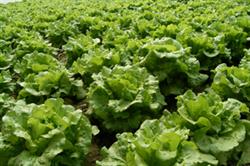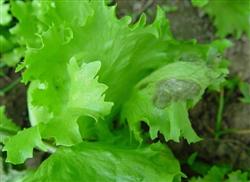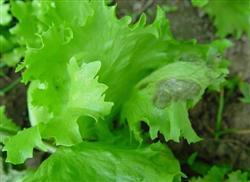High-yield cultivation techniques of lettuce

lettuce likes cold climate, 12~13℃ growth robust, leaf bulb growth temperature is 16~18℃, high temperature easy to loose leaf bulb, resulting in bolting. Lettuce likes plenty of sunlight and grows strongly in sandy loam or light clay loam. Cultivation time should be from late autumn to early spring of the following year, that is, from mid-late October to mid-April of the following year. lettuce generally adopted seedling transplanting, attention should be paid to the following links: 1 sowing date to determine the head lettuce seedling age of about 30 days, about 60 days after planting can be listed. Therefore, production can be reasonably arranged according to the time of planting and marketing, and harvest can be carried out by stages. 2 seed treatment can be used dry seed sowing, but also seed after soaking germination. Dry seed sowing with seed dry weight of 3% of 75% chlorothalonil wettable powder dressing, mixing immediately after sowing. Soak seeds and germinate seeds in clean water at 20℃ for 3~4 hours, wash and drain water, put them into emery cloth or earthen basin, and germinate seeds at 20℃ for 2~3 days. Sowing can be done after germination. 3. Seeding seedlings in the middle and late September, selecting sandy soil or light clay loam as cultivation land, preparing soil 7~10 days before sowing, and requiring fine and smooth bed soil. 10 kg of sieved manure and 50 g of potassium dihydrogen phosphate are used for each 10 square meters of seedbed. Sowing seedbed irrigation plantar water, water infiltration after the seeds and sand mixed after sowing, covering 0.5 cm. 20~25 grams per mu for heading lettuce, 6~8 square meters for seedbed area for planting 1 mu. 4. After sowing and seedling stage management, keep 20~25℃ in the day and 15~18℃ at night, keep the ridge surface wet, and seedlings can be completed in 3~5 days. After emergence, the temperature was reduced to 18~20℃ during the day and 12~14℃ at night. Seedling 2~3 true leaves, plant spacing 6 cm ×8 cm, 5~6 true leaves when planting. 5000kg of decomposed farm manure and 10~ 15kg of ammonia, phosphorus and potassium compound fertilizer shall be applied to 5 mu for planting. Leveling the ridge, the width of the ridge is 0.8~1 meter, the row spacing of the fixed plants of the heading lettuce is 25 cm ×35 cm, and about 7500 plants are planted per mu. Cultivation and management 1. The temperature was kept at 16~20℃ before ball formation, 17~18℃ during ball formation and 15~20℃ at ground temperature. 2 fertilizer and water management after planting to keep the soil dry and wet, combined with watering cultivation pine, plant 8~9 leaves and the core period should be combined with watering mu ammonium nitrate 8~10 kg. Control watering at the later stage of ball setting to avoid soft rot. 3 Harvest planting about 50 days after harvest can be harvested according to market demand, but the harvest time should not be too long, so as not to cause cracking ball, reduce commodity. 4. The pest control is mainly aphid, which can be controlled by 40% dimethoate emulsifiable concentrate 1000~2000 times or sprayed with 25% Kuaishaling 50 ml to 50 kg water. The main diseases were downy mildew, gray mold and soft rot. Downy mildew can be sprayed on the back of leaves with 200~250 times solution of 40% ethyl phosphorus aluminum WP or 500 times solution of 58% metalaxyl manganese zinc WP. Gray mold can be sprayed with 50% carbendazim WP 600~700 times solution, once every 7~10 days, continuously sprayed 3~4 times. For soft rot, 72% agricultural streptomycin soluble powder 3000~4000 times solution can be sprayed once every 10 days, and continuously sprayed 2~3 times.
- Prev

Control techniques of Brown spot and Black spot of lettuce
Lettuce brown spot and black spot are considered to be mainly harmful to leaves. The leaf spot of brown spot shows two symptoms: one is water-stained at first, then gradually enlarged into round or irregular shape, brown to dark gray spot, ranging from 2mm to 10mm in diameter. Another kind is dark brown disease spot, the edge is irregular, the periphery has the water stain shape halo. Tide.
- Next

Characteristic description and control methods of lettuce rot
Pathogen Pseudomonascichorii,P.marginalis,P.viridiflava symptoms, also known as lettuce pseudomonas rot or bacterial leaf spot, is a bacterial disease. The plants in the early heading stage were easy to get sick, first the leaf margin was flooded, and gradually changed from light brown to dark green, and some mesophyll tissues withered.
Related
- Where is it suitable to grow horseradish in China? it is expected to see the middle altitude horseradish in Alishan.
- How to prevent tomato virus disease reasonably? (Control methods included)
- Many people like to plant towel gourd on the balcony. What are the main points of this method and management?
- What crops can chili peppers be mixed with?
- Fertilization techniques and matters needing attention in Tomato
- What are the grafting techniques for peach seedlings in spring?
- Harm and control methods of root swelling disease of Chinese cabbage
- What are the pests of sweet potatoes? How to prevent and cure it?
- Symptoms, causes and Control methods of navel Rot in Tomato
- The cause of "Cucumber rotten bibcock" in Farmers' planting Cucumber and its Control Plan

